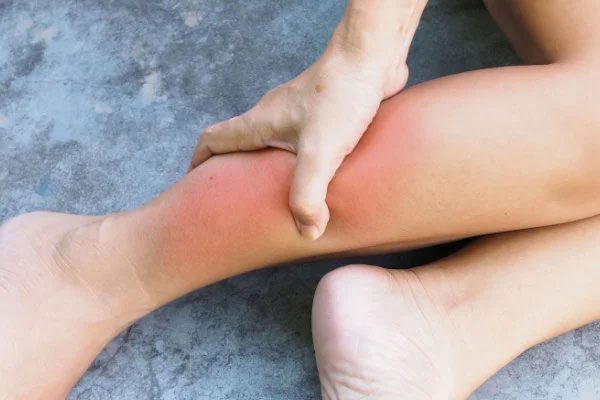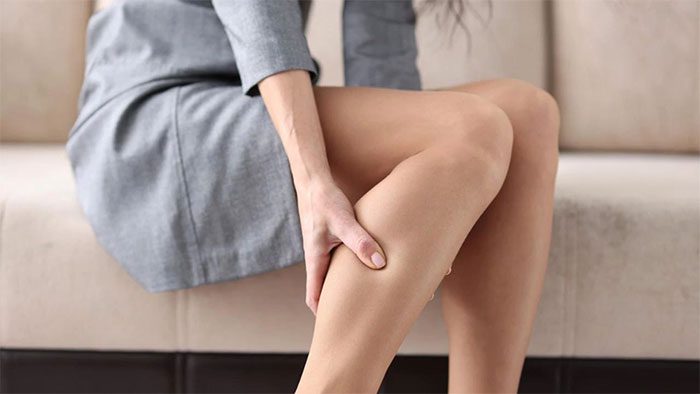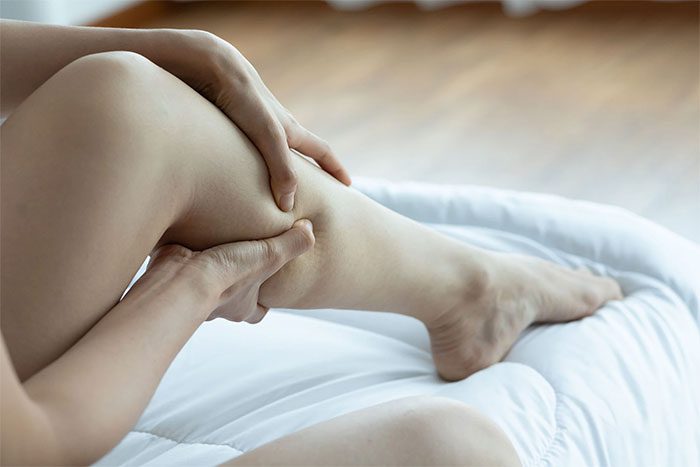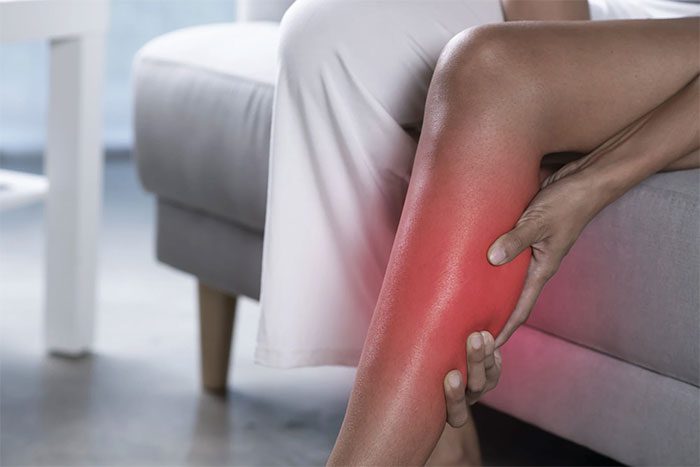The calf is the area of muscle at the back of the lower leg. It is formed by the following muscles: the gastrocnemius muscle, which is the larger muscle of the calf that creates the bulging mass visible under the skin. Calf pain can be caused by numerous factors.
Essential Information About Calf Pain
1. What does calf pain feel like?
The intensity of calf pain depends on its origin. Some people experience a dull ache or sharp pain in the back of the lower leg, while others may feel tightness, discomfort, or a tingling sensation like pins and needles.
Symptoms that indicate calf pain could be serious and warrant contacting a doctor include:
- Swelling in the calf
- Calf appears blue, pale, or unusually cool to the touch
- Unpleasant tingling or numbness in the calf and foot
- Sudden weakness in the leg muscles
- Swollen, painful calf
- Calf is red, warm, and painful
- Severe calf pain that does not improve after a few days, affecting normal activities.
2. Causes of calf pain
Calf pain is often caused by muscle strain, cramps, or restless leg syndrome, but some conditions like peripheral artery disease or the occurrence of deep vein thrombosis (DVT) can also lead to this issue.

There are many causes for calf pain flare-ups. (Image: Internet).
2.1. Calf muscle cramps
Calf cramps occur when there is an involuntary, sudden contraction of one or more calf muscles. The sensation of a calf cramp is described as very tight and painful, and you may even notice distinct muscle knots or spasms.
After a cramp occurs, calf pain can persist for several days. Approximately 60% of adults experience calf cramps at night, lasting an average of 9 minutes per episode.
Causes of calf cramps can include fatigue from high-intensity exercise, deficiencies in vitamins B12 and D3, iron deficiency, electrolyte imbalance, or side effects from certain medications such as Klonopin (clonazepam), Celebrex (celecoxib), Ambien (zolpidem), and Naprosyn (naproxen). Sometimes, this may also indicate serious conditions such as hypothyroidism, diabetes, or kidney failure.
Pregnant women may also experience cramps leading to calf pain, especially in the third trimester.
2.2. Muscle strain
Muscle strain typically occurs due to fatigue, overexertion, or improper use of the muscle. Exercises that can easily lead to strain when starting out include long-distance running, cycling, and weightlifting. Calf pain from muscle strain is described as sudden, aching, and limiting range of motion.
Sometimes, a strain can be more severe, leading to muscle tears or ruptures that require immediate medical attention.
2.3. Achilles tendonitis
Achilles tendonitis is a condition where the Achilles tendon is overused, leading to excessive stress and strain, causing damage to the heel area.
Common symptoms of Achilles tendonitis may include inflammation, pain, and stiffness in the back of the lower leg. Simple home treatments like stretching, reducing activity intensity, resting, and taking over-the-counter pain relievers can be helpful.

Is calf pain dangerous? (Image: Internet).
2.4. Sciatica
Sciatica refers to pain along the sciatic nerve, often resulting from compression of the lumbar nerve roots in the lower back. These nerves control muscles in the lower leg and the back of the knee. When pain occurs, patients may feel discomfort, numbness, and tingling in the lower back, which then radiates down to the leg, calf, and other areas.
To alleviate calf pain caused by sciatica, applying heat or cold, using over-the-counter pain medications, physical therapy, and avoiding prolonged sitting or standing can be effective.
2.5. Deep vein thrombosis (DVT)
Deep vein thrombosis means there is one or more blood clots in the body’s deep veins. Deep veins are found in the limbs and body, unlike the superficial veins you see on the hands and arms.
Common symptoms of DVT may include sudden swelling and pain in the calf; swelling in the foot, ankle, or leg; cramps; leg pain; skin color changes; veins becoming hard or thickened; and the affected area feeling warmer to the touch.

The treatment for calf pain varies depending on the cause. (Image: Internet).
2.6. Osteomyelitis
Osteomyelitis is the inflammation and destruction of bone structure caused by bacteria, tuberculosis, or fungi. Common symptoms include localized bone pain and systemic symptoms (in acute osteomyelitis) or no systemic symptoms (in chronic osteomyelitis).
With this condition, you may experience continuous, dull calf pain or a sensation of heat, swelling, and redness in the leg; in some cases, it may be accompanied by fever.
2.7. Peripheral artery disease (PAD)
Peripheral artery disease (PAD) is a condition characterized by atherosclerosis in the arteries (almost always in the lower extremities) causing ischemia due to the buildup of fatty substances in the arteries of the upper and lower limbs.
PAD in the calf arteries is characterized by cramping pain during activity (claudication), pain in the buttocks, hips, thighs, calves, or feet when walking short distances.
2.8. Popliteus tendinitis
The popliteus tendon is located around your knee joint, connecting the femur to the popliteus muscle just below the knee. The popliteus tendon and muscle work together to rotate and stabilize your knee. Popliteus tendinitis occurs when the tendon becomes inflamed, often due to overuse.
Pain from popliteus tendinitis is described as discomfort just above the calf, at the back and on the side of the knee. The pain worsens when walking or running downhill.

Restless leg syndrome causes discomfort and pain at night. (Image: Internet).
2.9. Baker’s cyst
A Baker’s cyst is a fluid-filled sac located at the inner side of the popliteal fossa and is completely benign. This cyst may communicate with the knee joint and can be associated with degenerative changes in the posterior horn of the medial meniscus, with or without a meniscal tear. Joint fluid accumulation occurs, pooling behind the knee, and is common in individuals with arthritis.
If this cyst ruptures, the fluid may leak down into the calf area, causing pain and swelling.
2.10. Restless leg syndrome
Restless leg syndrome causes a restless feeling in the legs, with discomfort and pain at night; the unpleasant pain intensifies at night, especially when you go to bed, differing from joint pain.
In addition to the conditions mentioned above that can cause calf pain, injuries such as calf muscle tears or bruises should also be noted for timely emergency care.
Depending on the cause of calf pain, doctors will recommend appropriate treatment measures. Resting, elevating the legs, and applying cold compresses are among the quickest ways to relieve calf pain. Physical therapy, medications, or surgery should be discussed with a doctor.
There are also some measures to help reduce the risk of calf pain by modifying daily lifestyle habits, such as warming up before exercise, avoiding overexertion, staying hydrated to prevent cramps, quitting smoking, maintaining a healthy weight, and eating a balanced diet.


















































